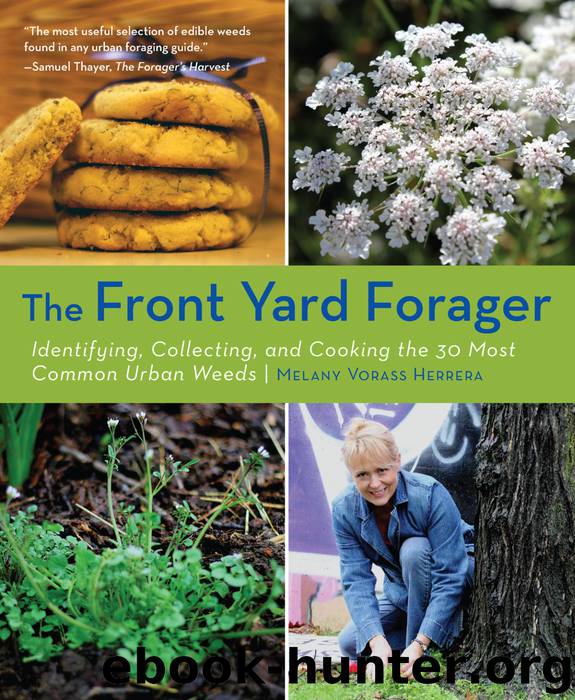Front Yard Forager by Melany Vorass

Author:Melany Vorass
Language: eng
Format: epub
ISBN: 9781594857485
Publisher: Mountaineers Books
Published: 2013-12-12T05:00:00+00:00
IN THE FIELD
What It Looks Like: Dense deciduous shrub 6–9 feet high and across; stems bear numerous hooked prickles. While we usually refer to roses as having thorns, sharp protrusions along rose stems are actually outgrowths of the epidermis (outer layer of stem tissue) called prickles (true thorns are modified stems always originating at a node). Rose prickles are generally curved hooks used to hang onto other vegetation as the rose plant grows over it. Despite these prickles, roses are frequently browsed by deer. Foliage has a strong applelike fragrance. Leaves pinnate, 2–4 inches long, with five to nine rounded to oval leaflets with a serrated margin and numerous glandular hairs. Flowers fragrant, ¾–1¼ inches in diameter, with five pink petals paler toward the base. Numerous yellow stamens. Flowers produced in clusters of two to seven from late spring through midsummer. Fruit a round to oblong red hip, growing to 1½ inches in diameter. R. rubiginosa hips are one of the tastier varieties. Rosehips have an outer fleshy layer (the edible part) called the hypanthium, which contains 5–160 achenes (fruits) held in a fine web of stiff hairs. Each achene contains a single seed. Seeds are dispersed in droppings of fruit-eating birds such as thrushes and waxwings.
Where to Find: Throughout much of Canada and most of the United States, except Arizona, Florida, Hawaii, Louisiana, Nevada, New Mexico, North Dakota, and South Dakota. This species grows well in either full sun or partial shade. Though it prefers moist sites and is often found growing along roadside ditches and river banks, sweet briar rose tolerates a wide variety of soils and growing conditions, even surviving floods and long periods of drought.
When to Harvest: Gather petals, shoots, and leaves any time they are present. Rose hips begin to form in spring and ripen in late summer through autumn; harvest hips after first frost when they are fully colored but not overripe. Best when they yield to gentle pressure but are also quite fine after they’ve shriveled and become soft. If you pick rose hips a little early, place them in the freezer for a few hours to imitate a frost. In late summer and early autumn, plants often bear fruit and flowers at the same time.
What to Eat: Rose hips, petals, young shoots, young leaves.
How to Harvest: Be careful of prickles; wear long sleeves, long pants, and gloves, but note that dexterity is greatly reduced by wearing gloves. If I see a good bush, I pick regardless of what I am wearing. Make sure rose petals you’re going to use are pesticide free.
Poisonous Look-Alikes to Avoid: None.
Download
This site does not store any files on its server. We only index and link to content provided by other sites. Please contact the content providers to delete copyright contents if any and email us, we'll remove relevant links or contents immediately.
Sapiens: A Brief History of Humankind by Yuval Noah Harari(14244)
The Tidewater Tales by John Barth(12608)
Mastermind: How to Think Like Sherlock Holmes by Maria Konnikova(7222)
Do No Harm Stories of Life, Death and Brain Surgery by Henry Marsh(6887)
The Thirst by Nesbo Jo(6826)
Why We Sleep: Unlocking the Power of Sleep and Dreams by Matthew Walker(6618)
Life 3.0: Being Human in the Age of Artificial Intelligence by Tegmark Max(5474)
Sapiens by Yuval Noah Harari(5293)
The Longevity Diet by Valter Longo(5017)
The Body: A Guide for Occupants by Bill Bryson(4973)
The Rules Do Not Apply by Ariel Levy(4842)
The Immortal Life of Henrietta Lacks by Rebecca Skloot(4523)
Animal Frequency by Melissa Alvarez(4394)
Why We Sleep by Matthew Walker(4358)
The Hacking of the American Mind by Robert H. Lustig(4318)
Yoga Anatomy by Kaminoff Leslie(4303)
All Creatures Great and Small by James Herriot(4228)
Double Down (Diary of a Wimpy Kid Book 11) by Jeff Kinney(4204)
Barron's AP Biology by Goldberg M.S. Deborah T(4095)
